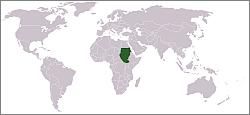| | The source of the following info is listed in the Links page, Sudan secion.


| National name | Jamhuryat as-Sudan
|
President |
Lt. Gen. Omar Hassan Ahmad al-Bashir (1989)
|
Area |
967,493 sq mi (2,505,810 sq km)
|
Population (2005 est.) |
40,187,486 (growth rate: 2.6%); birth rate: 35.2/1000; infant mortality rate: 62.5/1000; life expectancy: 58.5; density per sq mi: 42
|
Capital (2003 est.)
|
Khartoum, 5,717,300 (metro. area), 1,397,900 (city proper)
|
Largest cities |
Omdurman, 2,103,900; Port Sudan, 450,400
|
Monetary unit |
Dinar
|
Languages |
Arabic (official), Nubian, Ta Bedawie, diverse dialects of Nilotic, Nilo-Hamitic, Sudanic languages, English
|
Religions |
Islam (Sunni) 70% (in north), indigenous 25%, Christian 5%
|
Economic summary |
GDP/PPP (2004 est.): $76.19 billion; per capita $1,900.
Real growth rate: 6.4%.
Inflation: 9%.
Unemployment: 18.7% (2002 est.).
Arable land: 7%.
Agriculture: cotton, groundnuts (peanuts), sorghum, millet, wheat, gum arabic, sugarcane, cassava (tapioca), mangos, papaya, bananas, sweet potatoes, sesame; sheep, livestock.
Labor force: 11 million (1996 est.); agriculture 80%, industry and commerce 7%, government 13% (1998 est.).
Industries: oil, cotton ginning, textiles, cement, edible oils, sugar, soap distilling, shoes, petroleum refining, pharmaceuticals, armaments, automobile/light truck assembly.
Natural resources: petroleum; small reserves of iron ore, copper, chromium ore, zinc, tungsten, mica, silver, gold, hydropower.
Exports: $3.395 billion (f.o.b., 2004 est.): oil and petroleum products; cotton, sesame, livestock, groundnuts, gum arabic, sugar.
Imports: $3.496 billion (f.o.b., 2004 est.): foodstuffs, manufactured goods, refinery and transport equipment, medicines and chemicals, textiles, wheat.
Major trading partners: China, Saudi Arabia, UAE, UK, Germany, India, France (2003).
|


Sudan, in northeast Africa, is the largest country on the continent, measuring about one-fourth the size of the United States. Its neighbors are Chad and the Central African Republic on the west, Egypt and Libya on the north, Ethiopia and Eritrea on the east, and Kenya, Uganda, and Democratic Republic of the Congo on the south. The Red Sea washes about 500 mi of the eastern coast. It is traversed from north to south by the Nile, all of whose great tributaries are partly or entirely within its borders.

Three Kushite and Meroetic kingdoms called northern Sudan their home in ancient times, this region was also known as the Nubian Kingdom and these civilizations flourished mainly along the Nile River from the first to the sixth cataracts. These kingdoms were influenced by, and in turn influenced Pharaonic Egypt. In fact, the borders of the ancient Egyptian and Sudanese kingdoms fluxated greatly and what is now the upper third of present day Northern Sudan was during ancient times indistinguishable from Upper Egypt.
Although Christianity had been introduced into Sudan in the third or fourth centuries, around AD 640, Islam came to Sudan. A merchant class of Arabs established themselves as economically dominant in feudal Sudan. Important kingdoms in the next 1200 years include Makuria and the Kingdom of Sennar.
In 1820, Sudan came under Egyptian rule when Mehemet Ali, the Ottoman viceroy of Egypt sent armies under his son Ismail Pasha and Mahommed Bey to conquer eastern Sudan. Religious leader Muhammad ibn Abdalla, the self-proclaimed Mahdi (Messiah), attempted to unify the tribes of western and central Sudan in the 1880s. He led a nationalist revolt against Egyptian rule culminating in the fall of Khartoum in 1885, in which the British General Gordon was killed, the inspiration for Rudyard Kipling's poem Fuzzy Wuzzy, a tribe in the region of Port Sudan. The Mahdist state survived until being overwhelmed by an Anglo-Egyptian force under Lord Kitchener in 1898. Britain ran Sudan as two essentially separate colonies, the south and the north, until 1956.
The year before independence in 1956, Southern Sudanese embarked upon a civil war. During the British rule, laws had been put in place making it illegal for anyone living above the 10th parallel to go further south and anyone above the 8th parallel further north. The British law set the country up for this envitable conflict with this law. The law was enacted to prevent the spread of malaria and other tropic diseases that had ravaged British troops. Furthermore, while the British built roads, schools and set up a government in the predominately Arab north, the British left the South to Missionaries to "tame the savages" creating a terrible misjustice in the country. This sparked 17 years of civil war from 1955 to 1972. In 1972, the Addis Ababa Agreement led to a cessation of the north-south civil war and a degree of self-rule. This led to a ten-year hiatus in the civil war.
In September 1983, then President, Gaafar Nimeiry, created a Federated Sudan which included 3 federal states in Southern Sudan. It was the introduction of Sharia law and the dissolution of the 3 federal states in the South that led to the reinvigoration of the civil war.
Peace talks between the southern rebels and the government made substantial progress in 2003 and early 2004, although skirmishes in parts of the south were reportedly continuing. The peace was consolidated with the official signing by both sides of the Naivasha treaty on 9 January 2005, pursuant to which the south will be granted autonomy for six years, to be followed by a referendum on independence. It is hoped that the treaty will finally mark the end of a decades-long war that has claimed millions of lives. Now there is peace between the north and the south. Intertribal war still exists in the western region of Darfur.
| |
